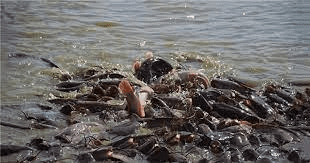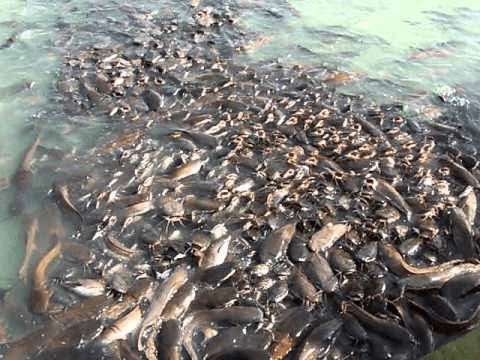Fish farmers often ask, is it necessary to have a point in my fish pond where I put the fish’s feed regularly? Well, It is necessary to have fish feeding points in the pond.
This will help prevent feed wastage which may result from throwing the feed into the pond if there is no feeding point. However, there must be enough feeding points so that all the fish can have access to the feed.
For instance, I recommend four feeding points to a pond that can house 1000 fish. Having feeding points will also help to know the feeding habits of the fish and those that are not feeding well will be detected early.
Fish feed is a major expenditure for fish farmers. Good fish feed management can reduce overall culture cost, improve fish farm environment and ensure healthy growth of fish stock.
Fish feed management includes choosing the right feed, using a correct feeding method, calculating the feeding cost and ensuring the cost effectiveness of fish farm.
Essential Nutrients for Fish
Protein, fat, carbohydrates, vitamins and minerals are the essential nutrients for fish. Protein provides energy and builds muscles. Protein Fat provides fish with energy.
A right amount of fat can improve taste and texture but excessive fat may pose a health hazard to fish. deficiency means slower growth whereas excessive protein will put up the feeding cost.
Carbohydrates provide energy but most of them are not easily digested by ordinary carnivorous species. Vitamins and minerals are the essential trace elements that can enhance natural resistance and feed conversion rate.
How Often Should I Feed My Fish (Fish Feeding)?

For the most part, feeding your fish once or twice a day is sufficient. Some hobbyists even fast their fish one or two days a week to allow them to clear their digestive systems. Larger, more sedentary fish can go longer between meals than smaller, more active fish.
Herbivores forage throughout the day, so they should be fed more frequently, however, only small quantities at a time. Small active fish like danios and newly hatched fry have higher metabolic rates and should be fed frequently, especially when kept at warmer temperatures. Water temperature regulates fishes’ metabolisms and influences how often and how much they need to be fed.
When Should I Feed My Fish?
In nature, most fish feed in the early morning and at dusk. Exceptions are herbivores and omnivores that forage throughout the day, and nocturnal species.
Although aquarium fish can be fed at any time of day, morning and evening feedings are best. They quickly learn when feeding time is, eagerly swimming back and forth at the surface or emerging from hiding places in anticipation of their next meal.
Make sure the aquarium light has been on for at least 30 minutes before the morning feeding and leave it on for at least 30 minutes after the evening feeding. Nocturnal species such as knifefish, catfish and certain plecostomus can be fed sinking foods shortly after the aquarium light is turned off at night.
Read Also: Maggot Feeding: Can I feed my fish only on maggots?
What Are the Signs of Overfeeding Fish?
The term overfeeding means feeding more food than your fish needs or wants to eat in one feeding. Even hobbyists who only feed once a day or every other day can be guilty of overfeeding if the food is not completely consumed in less than 2 or 3 minutes. Here are some tell-tale signs of overfeeding:
- Uneaten food remains in the aquarium after 5 minutes, but the fish show no interest in it. In extreme cases, a fuzzy or cottony white fungus may begin to grow on the bottom or on decorations and plants.
- Aquarium water is cloudy or hazy and has a foul odor to it. Foam or froth may be present on the surface.
- Filter media becomes clogged in a matter of days after cleaning.
- Excessive algae growth. Even with proper filtration and water changes, nitrate and phosphate accumulation from heavy feeding can contribute to excessive algae growth.
- Ammonia or nitrite levels are elevated.
- Chronically high nitrates or low pH.
How Much Should I Feed My Fish?
It’s always best to underfeed, especially in new aquariums, as uneaten food can cloud your water and cause dangerous rises in ammonia and nitrite levels. A general rule of thumb is to feed only what your fish can consume in 2 to 3 minutes.
When in doubt, start with a tiny quantity and observe how fast your fish consume it. If it is completely consumed in less than 2 minutes, give them a little more. It won’t take long to figure out how much food to give them at each feeding. Remove any food that remains after five minutes with a siphon hose or net.
Another consideration is what part of the water column your fish feed in. Fish can be:
- Surface feeders
- Mid-water feeders
- Bottom feeders
Most fish will learn to take food wherever it’s available, but shy fish may wait until food drifts into their safe zone. These fish may need to be target fed, meaning directing food right to them.
Flakes and some pellet foods typically linger at the surface for a minute or two before beginning a slow descent to the bottom, making them good choices for surface and mid-water feeders.
Soaking dried foods or swishing them at the surface will help them drop faster for mid-water feeders. Most catfish, loaches and other bottom feeders do best on sinking tablets, wafers and pellet foods. Providing your fish with the right diet and feeding schedule will ensure growth, disease resistance, vibrant colors, and long, healthy lives.
Read Also: How to Build a Raised Bed Garden






